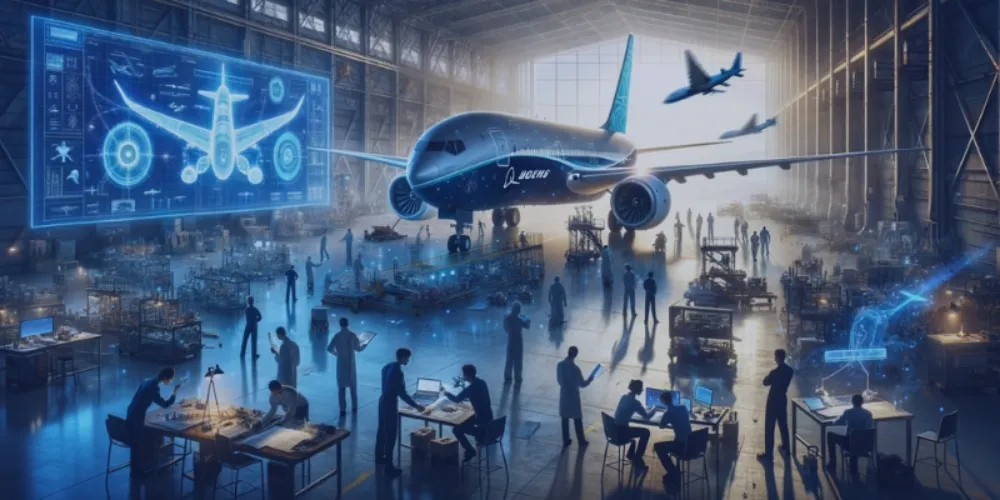What are Maquiladoras?
Maquiladoras are manufacturing facilities in Mexico that work together with a company’s main office in the United States. These plants let businesses take advantage...
By AMREP | Posted on September 10, 2024

On 24 August 2024, NASA announced that the astronauts Sunita Williams and Barry ‘Butch’ Wilmore would need to wait until next year to be safely returned to Earth. The astronauts were originally meant to make a 8 day trip to the International Space Station (ISS) using Boeing’s Starliner spacecraft, but technical difficulties during the flight meant that they had to stay on the ISS while engineers worked on the problems. The astronauts have already been in space for 8 months.
Once again this brings unwanted attention and adds to the long list of problems for Boeing. The aerospace manufacturer already has come under heavy fire for its quality control issues and is under investigation by the Federal Aviation Authority. In January 2024, a door panel blew out on one of its 737 Max airplanes, adding to an extremely troubled history of catastrophic failures with the Boeing 737 aircraft. Even more recently, in August 2024, Boeing suspended flight testing of its new 777X wide-body jet after identifying the failure of a part connecting the engine to the body of the aircraft.
The Boeing 737 MAX is the fourth generation of the Boeing 737. Following the fatal crashes of Lion Air Flight 610 and Ethiopian Airlines Flight 302, the global fleet had to be grounded worldwide from March 2019 to November 2020 as the causes of the crashes were investigated.
The key findings were:
MCAS System Flaws: The Maneuvering Characteristics Augmentation System (MCAS) was designed to enhance the aircraft's stability but was implicated in both crashes. The system’s software was found to be flawed, relying on single sensor inputs and lacking redundancy. Additionally, pilots were not fully informed about how MCAS functioned or how to override it in an emergency.
Design and Certification Rushed: Boeing’s push to quickly develop and certify the 737 MAX to compete with Airbus’s A320neo led to a rushed design and certification process. Investigations suggested that Boeing may have compromised on safety aspects to meet market demands and cost targets.
Inadequate Pilot Training: The training provided to pilots on the new systems, particularly MCAS, was insufficient. This lack of adequate training contributed to difficulties in handling the system’s failure during emergencies.
In 2024, a door panel blew out of an unused exit doorway on Alaska Airlines Flight 1282. The FAA grounded the aircraft fleet again and did a six week audit of Boeing’s production of the 737 Max jet.
The findings were quite surprising. Boeing failed 33 out of 89 product audits with a total of 97 instances of alleged noncompliance. Spirit AeroSystems, its supplier who makes the fuselage of the 737 Max, was found to have failed 7 out of 13 product audits.
The Boeing 787 Dreamliner, introduced as a technologically advanced and fuel-efficient aircraft, faced its own set of quality problems:
Manufacturing Deficiencies: The 787 Dreamliner’s production process has been marred by several defects. Issues such as improper installation of critical components, structural defects in the fuselage, and inconsistencies in wing assembly have been reported. These problems led to significant delays in production and delivery, as well as increased repair and maintenance costs.
Complex Supply Chain: The 787’s reliance on an extensive global supply chain introduced variability in the quality of components. Boeing’s management of this complex network of suppliers was found to be inadequate, leading to inconsistencies and defects in the final product.
Inspection and Quality Control: The quality control measures in place for the 787 were found to be insufficient. Problems with inspection procedures allowed defects to go unnoticed, impacting the safety and reliability of the aircraft.
On 8 August 2024, NASA’s Office of the Inspector General released a report which was highly critical of Boeing’s quality control practices in the Starliner spacecraft and Space Launch System project. The Space Launch System was to be used in NASA’s next-generation megarocket.
The report flatly stated that Boeing’s quality management system did not adhere to the AS International AS9100D quality management systems or NASA requirements. The company did not have sufficient numbers of trained and experienced aerospace workers; numerous requests to rectify over 70 Corrective Action Requests were unattended to.
Aside from the specific technical issues with the 737 MAX and 787 Dreamliner, Boeing faced broader production and supply chain challenges that ultimately led to quality problems.
The fallout from Boeing’s quality problems continues. The FAA pursues its investigations into the company’s quality management practices and the whistleblower complaints. In May 2024, Boeing provided its corrective action plan which was to show all the actions it would take to strengthen its quality management system, operator work instructions, supplier oversight, employee and training programmes, and internal audits of the production system. Boeing just appointed a new CEO, Kelly Ortberg, whose first move was to base himself in Puget Sound, Washington, to be closer to the production floor rather than be in Boeing’s headquarters in Washington D.C.
For quality professionals like AMREP, Boeing’s quality problems are a parable and frightful example of just how poorly a company can handle quality issues. Quality Inspection Services are critical in identifying and mitigating risks before they escalate into major issues, as starkly demonstrated by the fatal crashes of the 737 Max airplanes and the incident with two astronauts stranded in space.
Boeing’s situation contains all the prime examples of what not to do in quality. Most of all, it shows us that good quality can only be attained if the management wills it and is open to acting on quality issues. It also shows that management has to be proactive in creating an open, transparent, and safe environment where employees can fearlessly report on quality issues and have confidence that management will consider their recommendations seriously. This open management culture has to be promulgated at every organization involved in a company’s supply chain.
Contact Us To See What We Can Do
Call Us
Mon - Sat 9.00 - 18.00
Sunday Closed


09 - September 2024
09
September
2024
Maquiladoras are manufacturing facilities in Mexico that work together with a company’s main office in the United States. These plants let businesses take advantage...

24 - July 2024
24
July
2024
ERP stands for Enterprise Resource Planning. It's a type of software that companies use to manage day-to-day business activities such as accounting, procurement...

23 - July 2024
23
July
2024
In manufacturing, the quest for efficiency, quality, and speed has led to the adoption of various methodologies aimed at enhancing productivity and reducing costs...
